Guest columnist Fred Van Lente pays tribute to one of comics’ greatest writers, who turns 81…
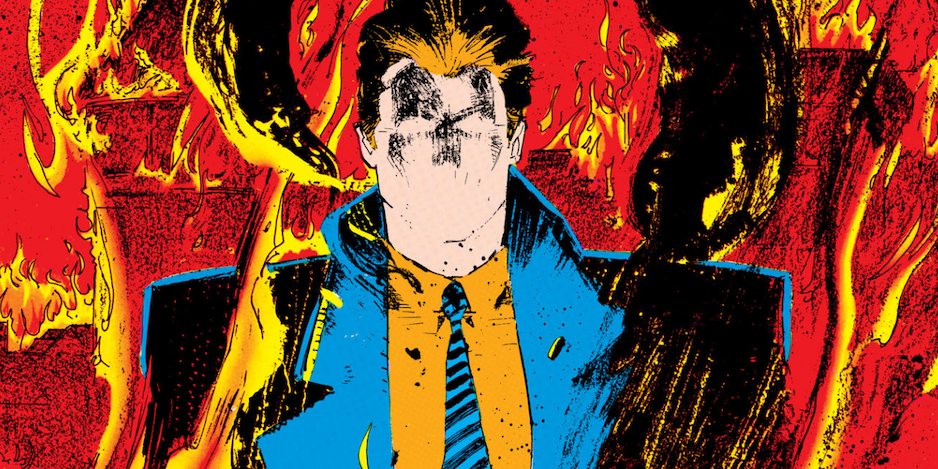
About a year ago, for the Dark Knight’s 80th anniversary, we convened a blue-ribbon panel to devise a list of the TOP 13 GREATEST BATMAN STORIES EVER — RANKED. (Click here. It rocks.) On the panel was comics writer/historian Fred Van Lente and behind the scenes, we went back and forth a little about our mutual love of Denny O’Neil, who is on a very short list of the best writers to ever fill a word balloon.
So when it came to celebrate O’Neil’s 81st birthday this year — he was born May 3, 1939 — I asked Fred if he wanted to take a crack at the TOP 13 O’Neil stories ever. I was poised to do it myself — and I probably will at some point — but I always enjoy inviting different viewpoints to 13th Dimension. Fred agreed immediately, and then caught me by a happy surprise. He didn’t do the TOP 13 O’Neil stories — he did the TOP 13 stories from what he considers O’Neil’s greatest book: Not Batman. Not Green Lantern/Green Arrow. But The Question.
Here, then, are THE TOP 13 DENNY O’NEIL THE QUESTION STORIES — RANKED:
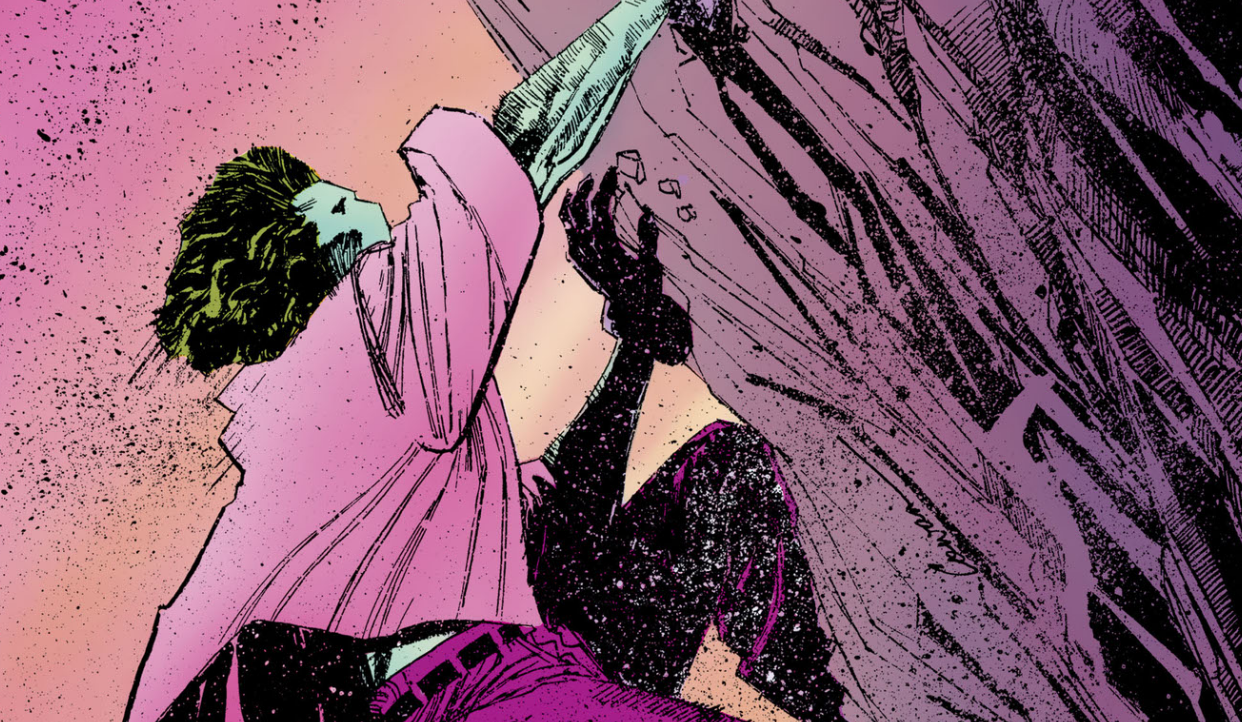
By FRED VAN LENTE
It is Dennis O’Neil’s birthday! And I hope it is a happy one for him and that many more follow. Dan asked me to rank the TOP 13 O’Neil stories, and while I appreciate his runs on Batman, Iron Man, Green Lantern/Green Arrow, and many others, O’Neil has also written what may very well be my favorite superhero comic book of all time — The Question, his shared masterwork with the great penciller Denys Cowan.
So I’m going to rank my TOP 13 issues of The Question and hopefully inspire you to hit the back issue bins and scrounge them up, since the series is criminally unavailable in collected form.
First, some background: In the 1960s Charlton Blue Beetle comic writer/artist Steve Ditko introduced Vic Sage as an objectivist vigilante who applies a relentless moral logic to criminals the establishment is too morally weak (i.e. politically liberal) or criminally corrupt to pursue. His faceless mask reflects uncompromising justice, not just blind but also anonymous, like a force of nature. “The Question” is an odd name for such a character, because he always knows exactly what the answer is.
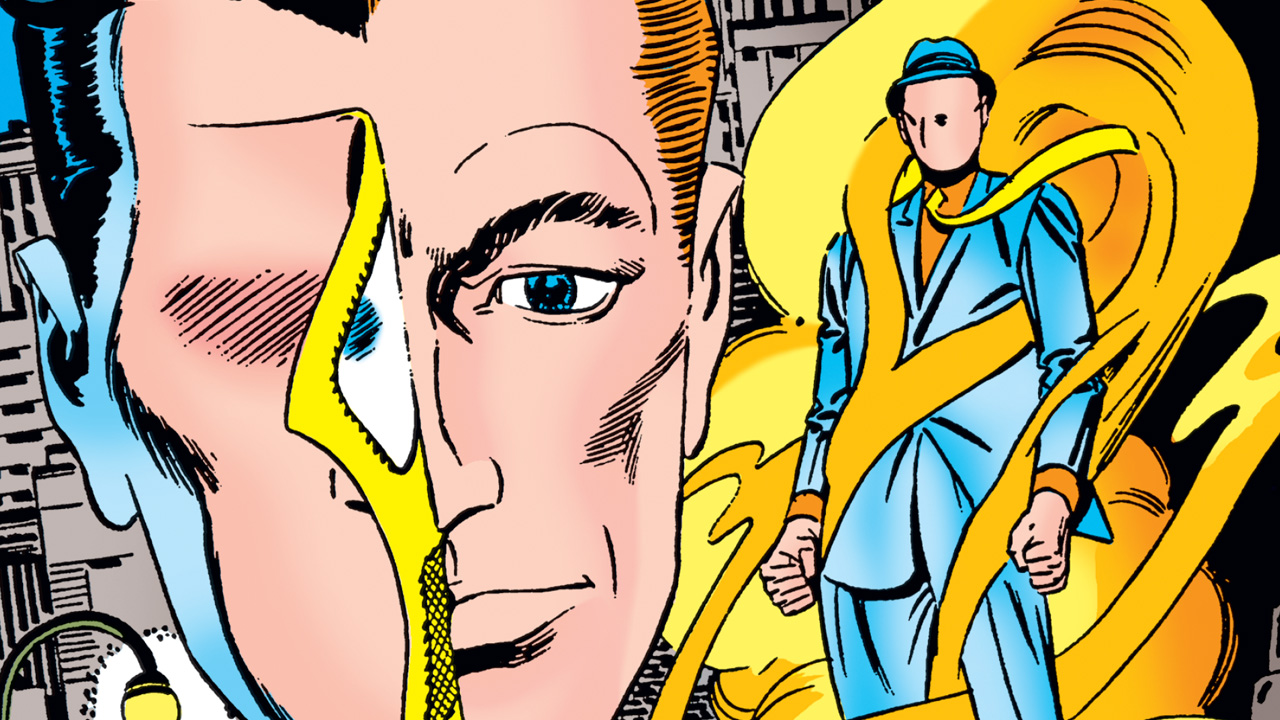
Ditko
O’Neil and Cowan turned Ditko’s Question on its head after DC acquired all the Charlton characters in the 1980s by making their Vic Sage the exact opposite, a Zen superhero who pursues truth because he has no idea what it is. An orphan of unknown parentage, Sage’s blank mask reflects the question mark-shaped hole in his own soul. As a kid with an interest in philosophy, and someone who would go on to do his own philosophy comic book, I was all-in the minute I got my hands on it, thanks to O’Neil’s terrific dialogue and thematic questioning and Cowan’s amazing silent panels of martial arts action.
But here are the 13 issues that showcase The Question at its best:
13. The Question #17: A Dream of Rorschach. Alan Moore twisted Ditko’s Question in another direction, into a racist crackpot, and, because we can’t have nice things, he quickly became Watchmen’s most popular character. In this meta-crossover-that-isn’t, Sage buys a copy of Watchmen at the airport and reflects on how similar he is to the fictional version — and how he’s different.
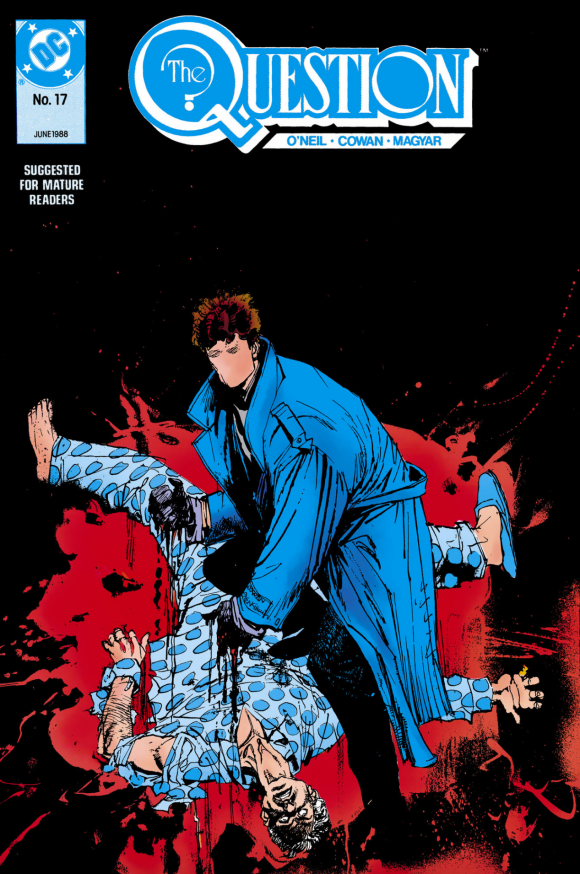
Interesting enough to make this list, but not good enough to get higher than 13th place, this is also the most recently-reprinted issue of the series, appearing with some roleplaying game modules and other ephemera in last year’s Watchmen Companion.
—
12. The Question Annual #2: Losing Face. Denys Cowan steps aside for the underrated Bill Wray and Shea Anton Pensa on art. Bad guys wearing faceless masks commit crimes that bring Green Arrow to Hub City looking for Vic Sage. This inspires a flashback as to how the mask came to be in the first place. Ultimately the mystery leads our heroes to the baroquely corrupt Caribbean nation of Santa Prisca (introduced in the regular Question series, later the birthplace of Bane). This is a weird, shaggy dog of a comic book, an oversized rush-job in typical Big Two annual fashion. But it’s still cool to find out where the mask comes from, and the ending is an excellent O’Neil philosophical soul-stumper.
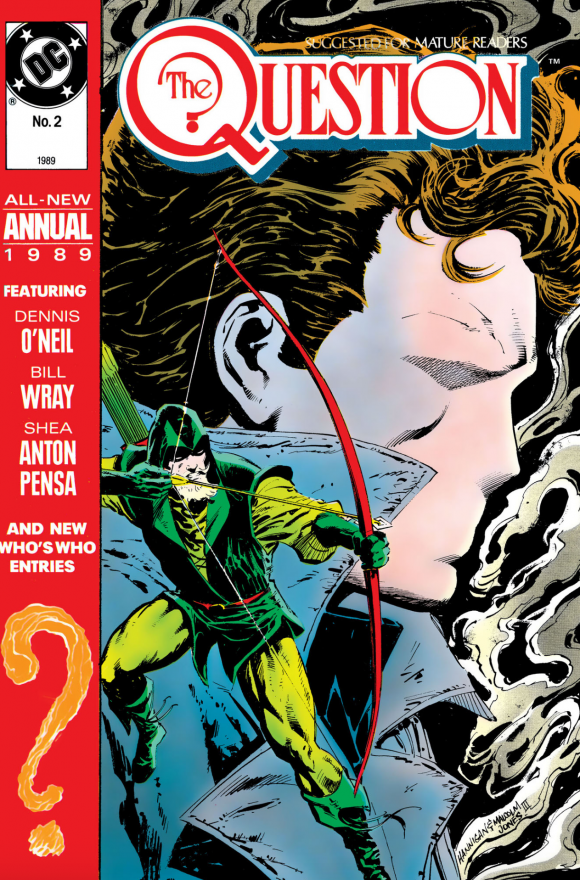
—
11. The Question #27: Captain Stars & Sergeant Stripes. There’s a famous bit when Steve Ditko’s Mr. A — who is basically the Question, but with a face — confronts a hood hanging off a building, begging him to pull him up. Mr. A doesn’t do what every other mass-media hero had ever done to that point, and lets the scumbag fall to his death. Little wonder Alan Moore said there’s as much Mr. A in Rorschach as the Question.
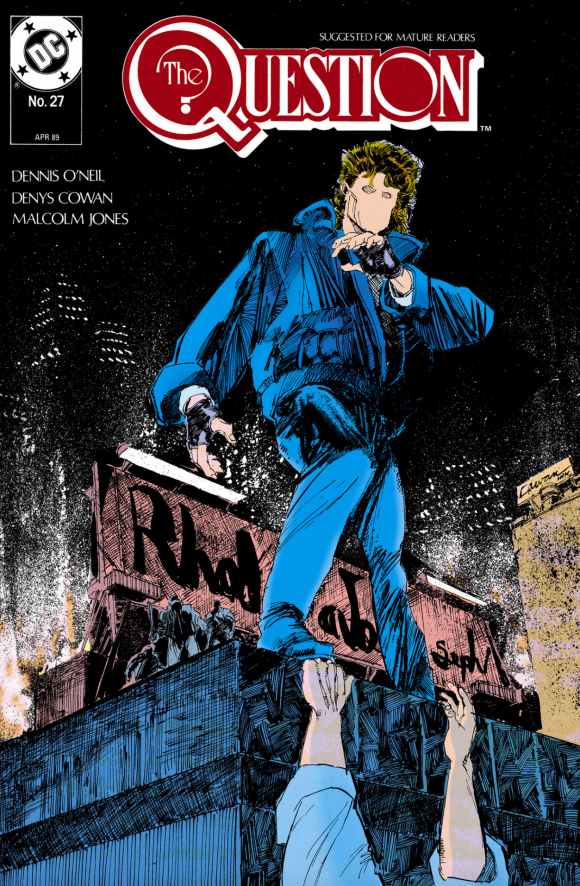
Vic Sage is confronted with the exact same scenario in this issue, and, well, it plays out a little bit differently, summing up the difference in Ditko and O’Neil’s philosophies. The main storyline, about a Golden Age comics creator who thinks he used image-magic to win World War II, is pretty rad too.
—
10. The Question #26: Riddles. In one of the only issues of the regular series not drawn by Denys Cowan — Bill Wray once again chips in here: A washed-up Riddler acquires a psychotic girlfriend and they decide to hold the Greyhound bus they’re on hostage. Passengers must correctly answer one of Edward Nigma’s riddles or get riddled with bullets. It’d be “What If Frank Gorshin starred in Natural Born Killers?” except the duo has accidentally netted the Question too, who has more than a few Zen koans up his sleeve.
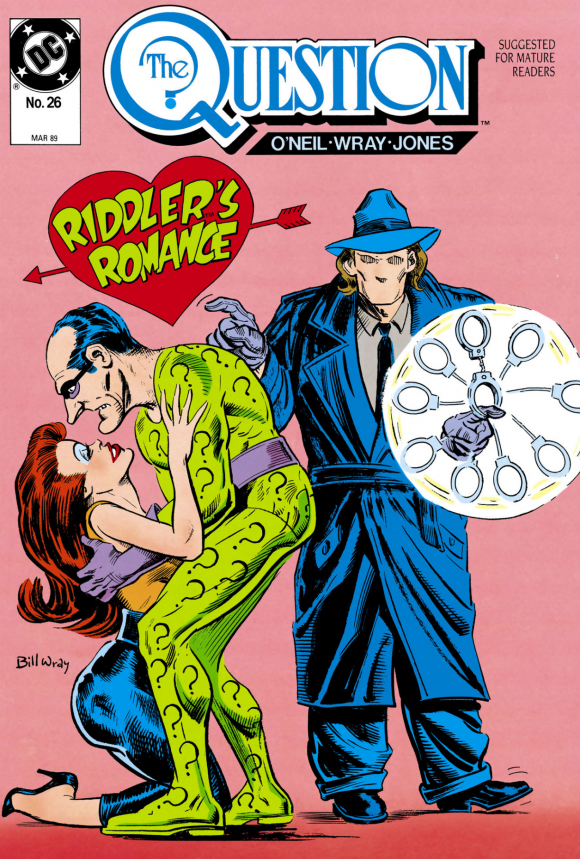
—
9. The Question #3. Suffer the Children. In my day, kids, which is to say, when I was a kid, comic book conventions were scary flea markets in cigarette-cloudy hotel ballrooms next to the highway. Yet I still convinced my dad to spend stray Saturday afternoons driving me to them, and it was here I bought my first Question comic — this one new, since my small Ohio town had no comics shop and this was a direct-market series. That amazing Cowan/Bill Sienkiewicz cover drew me in, and the story hooked me instantly, even though it is midway through the four-part saga of the Question’s battle against the corrupt Hub City government. But I loved Vic Sage’s whole Zen cool, the fact he was brave enough to admit what he didn’t know in a world awash in misguided certainty.

—
8. The Question #18: Desperate Ground. O’Neil uses strong character work to breathe life into a hoary superhero cliche: the hero-mistakes-another-hero-for-a-villain bit. Except that’s the whole story, here: Green Arrow has rescued a tied-up Question from some gunrunners, and since Oliver Queen doesn’t know who this guy is, and he has no face, Queen’s inclined to leave him tied up. Sage basically spends the rest of the issue convincing Ollie otherwise, and, of course, no one writes Green Arrow as well as O’Neil. (Sorry, everyone else who’s ever tried.) (Note from Dan: Want more O’Neil GA? Click here.)
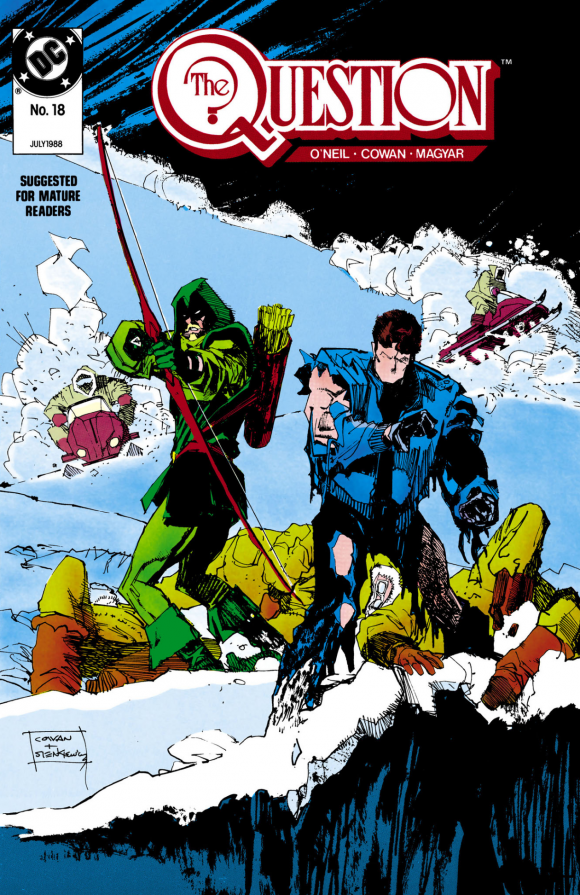
—
7. The Question #8: The Mikado. A serial killer is slaughtering Hub City’s worst citizens — which means he has no shortage of victims — in horrific Se7en-style tableaus that allow “the punishment to fit the crime,” as Gilbert and Sullivan’s Japanese executioner sang. A moving whodunit in that Sage figures out the identity of the killer early on, but pursues other possibilities because he doesn’t want it to be true.
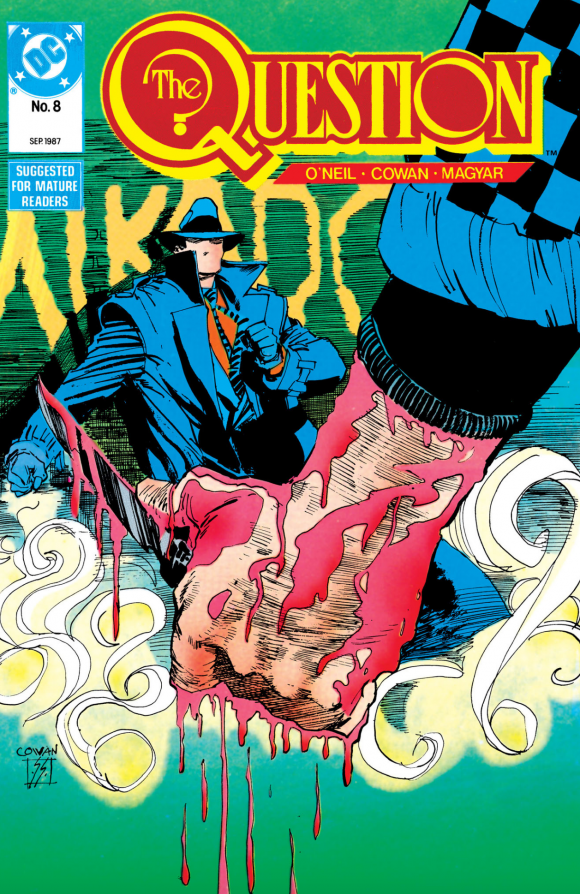
—
6. The Question #1: The Bad News. “Hub City, Friday, November 21, 10:45 PM: Charles Victor Szasz has exactly 25 hours and 15 minutes to live…”
With those words we meet Vic Sage, angry newsman, an orphan who doesn’t even know what his real name is. He has access to a creepy faceless mask when he wants to go beat up people for information that will help his career. When he makes enemies of the diabolical (literally) mayor’s office, though, the bad guys hire Lady Shiva to break every bone in his body, then they shoot him in the face and dump him in the river. (Spoilers?)
One of the greatest first episodes of any series, ever, right up there with The Shield pilot, and they have more than a few elements in common. Coincidence?
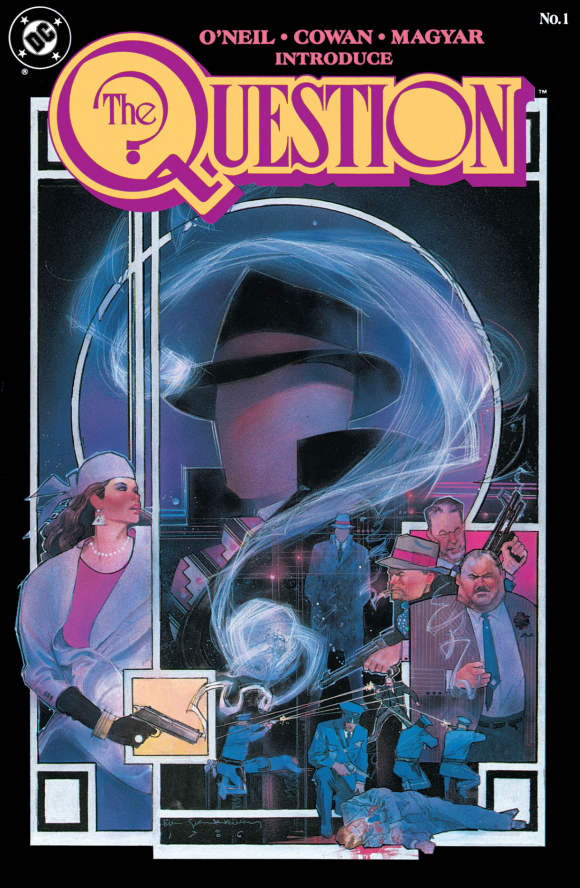
—
5. The Question #14: Saving Face. The rare great done-in-one single-issue comic that is entirely about the hero trying to get out of a deathtrap. A right-wing militia has buried Sage in the ground up to his neck, and if he lasts a certain amount of time without losing his mind, they’ll let him go. If he doesn’t, they shoot him. Simple. But also awesome. Years later, when I had to adapt the Robert E. Howard scene of Conan enduring crucifixion for Dark Horse, I kept thinking back to this comic.
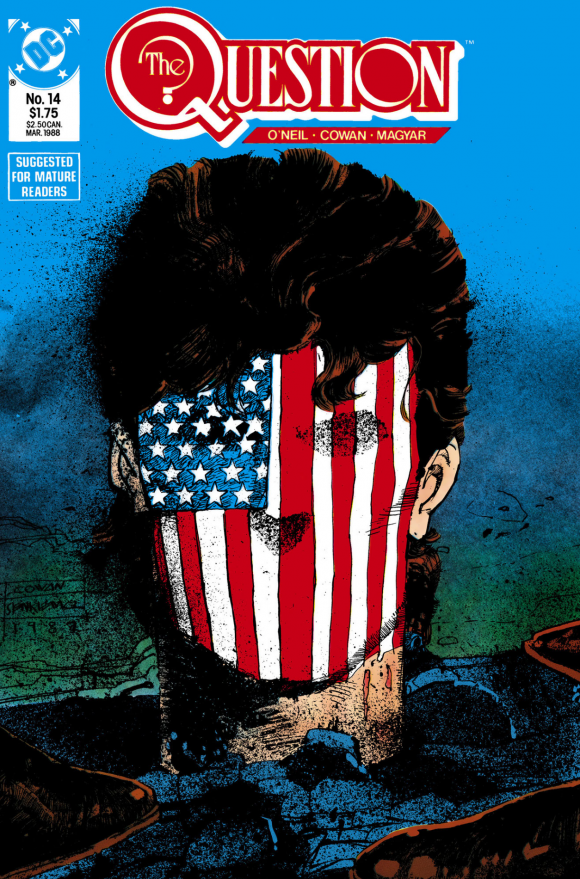
—
4. The Question #2: Butterfly. Seeing something more in Vic Sage than he sees in himself, Lady Shiva delivers a broken and beaten Question to an old friend with whom she co-starred in the 1970s Shang-Chi/Iron First DC ripoff Richard Dragon, Kung Fu Fighter, written by… Dennis O’Neil. The now-retired and wheelchair-bound Richard Dragon trains Sage in the more spiritual side of the martial arts, and here is the true beginning point of the series: A vigilante crime story in which the pursuit of truth is personal as well as universal.
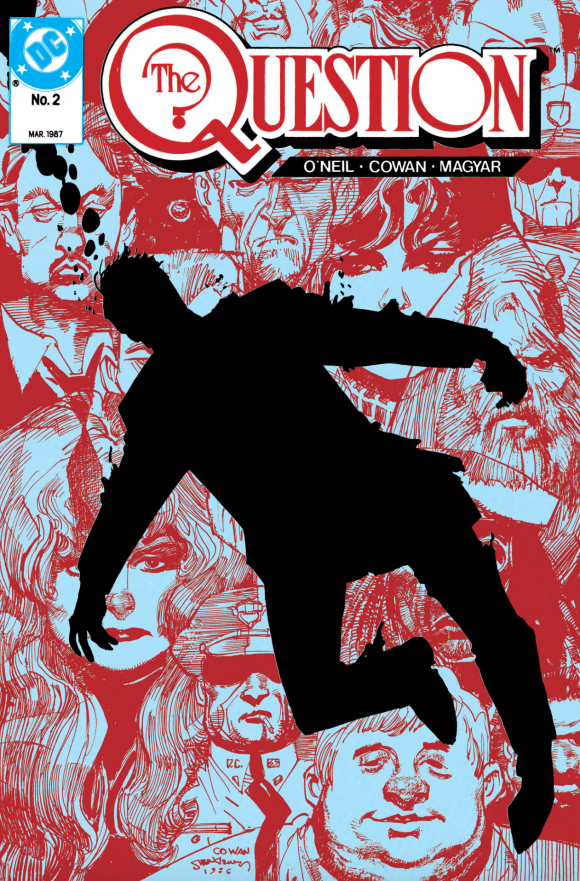
—
3. The Question #36. Or Maybe Gomorrah. In the second-best final issue of any superhero comic, ever — the best is Morrison and Case’s Doom Patrol, come on, it’s not even close — Sage has to choose, essentially, between Hub City and his own life and sanity. While nothing much happens, per se, the emotional honesty of the series has never been better. The Question has the freedom to do something Batman could never do, because Batman has to remain brooding in his cave for the sake of AT&T’s bottom line.
And this is why, friends, we should all be happy that none of us are Batman.
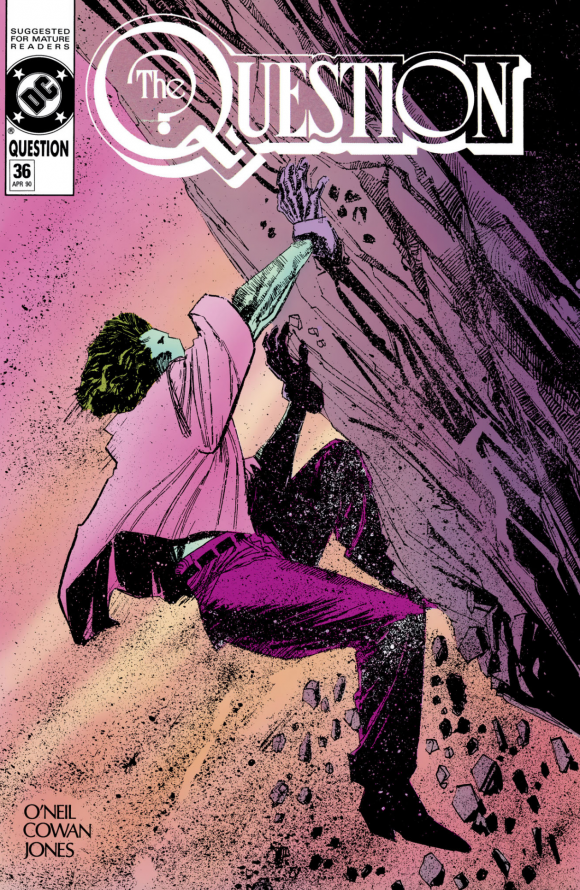
—
2. The Question #4: The Sacrifice. The showdown between Sage and the Reverend Hatch, the mayor’s insane spiritual advisor, who has dark designs for Hub City, and the entire world. Myra Connelly, ostensibly Sage’s love interest, has fallen with her daughter into the reverend’s clutches, and here a potentially stock damsel-in-distress becomes so much more. One of the greatest things about The Question is that, even though the villain is defeated, his plan ostensibly succeeds, and the slow-moving collapse of Hub City is the engine that makes the rest of the series go.
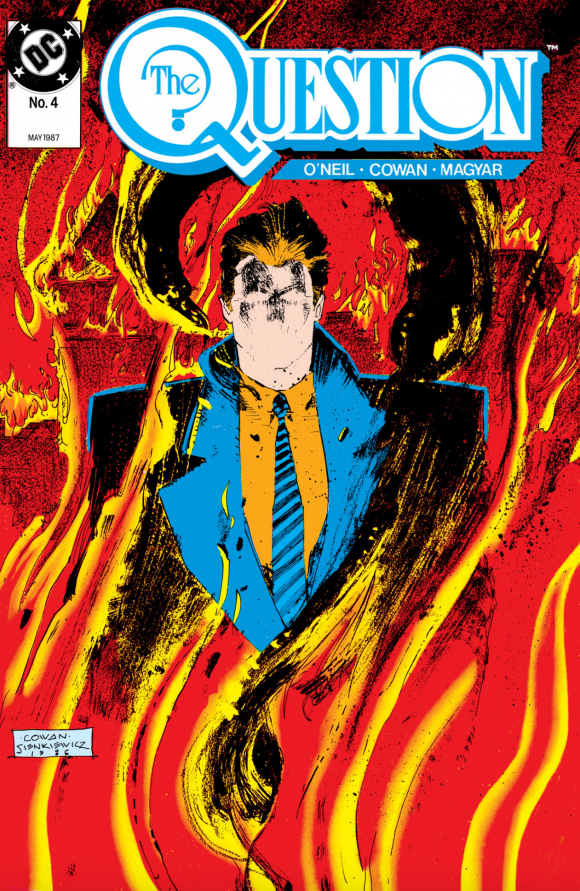
—
1. The Question Annual #1: The Silent Parable. The O Sensei is dying, and Lady Shiva recruits the Question, Green Arrow and Batman to help smuggle her mentor to a hostile island for burial. This is the last part of a three-annual connected story, but you don’t need to read the other two to appreciate this one. Part One, a Detective Comics Annual called The Monkey Trap, is a pretty great O’Neil/Klaus Janson Penguin-vs-Ra’s-al-Ghul tale in its own right, but the Part Two in Green Arrow Annual is forgettable.
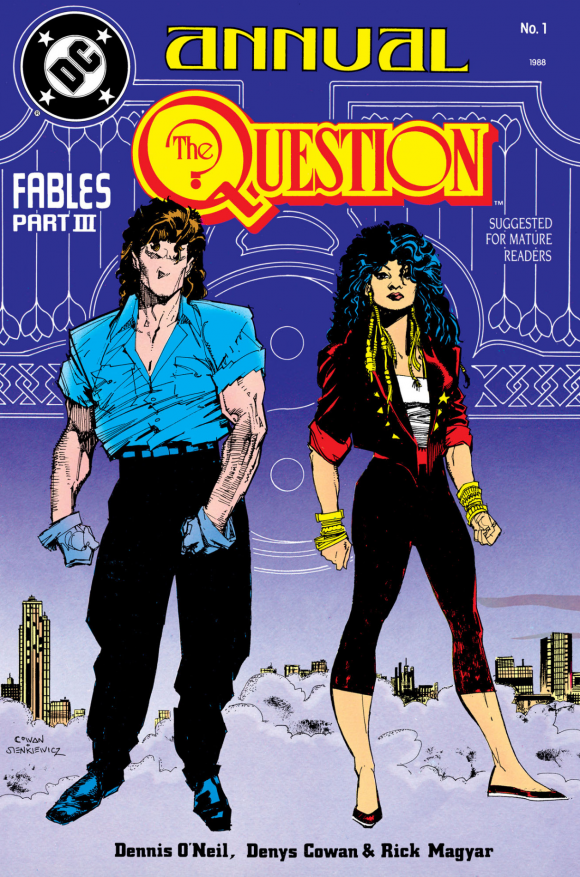
This, however, is probably my favorite single issue of all time. It’s hard for me to articulate why, but basically it is a pitch-perfect tale of failure and redemption. It is the only comic that makes me cry every time I read it, and I am getting a little choked up typing this out.
When Dan asked me to lay out my favorite Dennis O’Neil stories, there was no question this was #1, and the whole rest of The Question appreciation followed. Do yourself a favor and check it out, it’s on ComiXology for cheap. (You can also stream it on the DC Universe app.)
—
Fred Van Lente is the writer of The Comic Book History of Comics, Action Philosphers! and many other titles from many publishers. He knows his shit.
—
MORE
— When DENNY O’NEIL and MIKE GRELL Revamped GREEN ARROW’s Origin. Click here.
— DENNY O’NEIL Opens Up About His Greatest BATMAN Stories. Click here.

May 3, 2020
Great list! Love O’Neil’s Question!
May 3, 2020
Pure epicness!
May 4, 2025
And every comicbook did have a reading Suggestion from Denny O‘Neil.